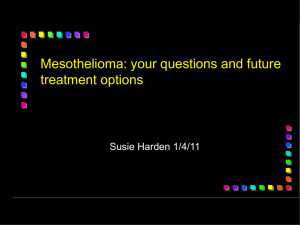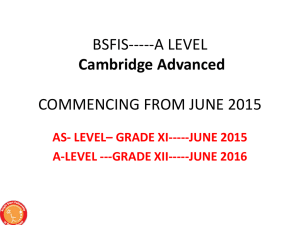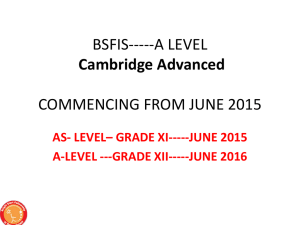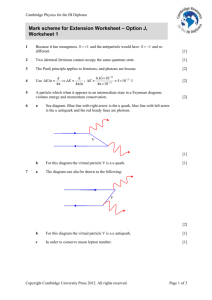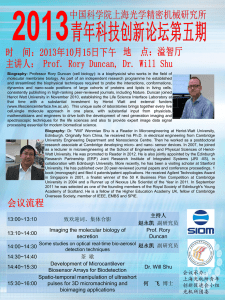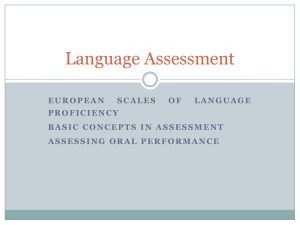Simulated Clinical Encounter Examination (SCEE)
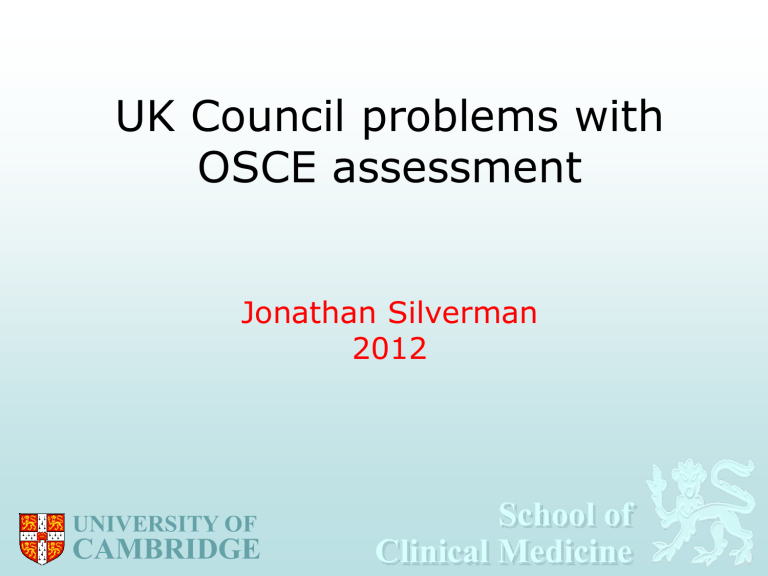
UK Council problems with
OSCE assessment
Jonathan Silverman
2012
UNIVERSITY OF
CAMBRIDGE
School of
Clinical Medicine
Reliable?
Valid ?
Sacrificed validity for reliability ?
Are the stations apples and pears?
Is it a glorified validity?
Has integration compromised the what?
Examiner training
CAMBRIDGE
Standard setting and
Are you disadvantaging the thoughtful shy student?
it wrong?
School of
Clinical Medicine
Utility function
U = wr
R x wv
V x we
E x wa
A x wc
C
• U = Utility
• R = Reliability
• V = Validity
• E = Educational impact
• A = Acceptability
• C = Cost
• W = Weight
UNIVERSITY OF
CAMBRIDGE
School of
Clinical Medicine
Domain based marking
The problem of atomised communication
The concept of professional judgement and flexibility and contextualisation
Internalised grids
Why this might not work in communication
The problem of too few domains
UNIVERSITY OF
CAMBRIDGE
School of
Clinical Medicine
Process Marking in information gathering stations:
7 overall scores
• Initiating the Session
• Problem Identification
• Problem Exploration
• Patient’s Perspective
• Non-verbal Communication
• Developing Rapport
• Providing Structure
UNIVERSITY OF
CAMBRIDGE
School of
Clinical Medicine
Process Grid
Initiating the session
Greets
patient and obtains patient’s name
Introduces self, role and nature of interview; obtains consent
Demonstrates interest and respect
, attends to patient’s physical comfort
Uses appropriate opening question
Overall Score for Initiating the Session
Gathering Information
Listens attentively, minimising interruption and leaving space for patient
Encourages patient to tell the story of the problem(s) from when first started to the present
Checks and screens
for further problems (eg, so that’s headaches, anything else you’ve noticed?)
Overall Score for Problem Identification
Uses open and closed questions , appropriately moving from open to closed
Facilitates patient's responses verbally and non–verbally e.g. silence, repetition, paraphrasing
Picks up and responds to verbal and non–verbal cues (body language, speech, facial expression)
Clarifies statements which are vague or need amplification
Periodically summarises & invites patient to correct interpretation or provide further information.
Uses clear, easily understood language, avoids jargon
Individual areas for guidance: overall areas marked only
Overall Score for Problem Exploration
Actively determines patient’s perspective
(ideas, concerns, expectations, feelings, effects on life)
Appropriately and sensitively responds to and further explores patient’s perspective
Overall Score for Patient’s Perspective
Building the relationship
Demonstrates appropriate non–verbal behaviour eg eye contact, posture, position, movement, facial expression, use of voice
Overall Score for Non-verbal Communication
Acknowledges patient's views and feelings; is not judgmental
Uses empathy
to communicate appreciation of the patient’s feelings or predicament
Provides support : expresses concern, understanding, willingness to help
Overall Score for Developing Rapport
Providing Structure
Progresses from one section to another using signposting ; includes rationale for next section
Structures interview in logical sequence , attends to timing , keeps interview on task
Overall Score for Providing Structure
Content marking
UNIVERSITY OF
CAMBRIDGE
School of
Clinical Medicine
Content grid
Symptoms
1.
tired, few months
2.
septic spots
3.
rash
4.
thirst
5.
polyuria
6.
weight loss
Other symptoms
7.
joint aches
8.
blurred vision
Relevant functional enquiry
9.
no loss of appetite
Ideas and thoughts
10.
diabetes
11.
hep C
Concerns
12.
amputations or blindness
Expectations
13.
tests
Feelings
14.
to be taken seriously
Past medical history
15.
migraine
16.
hepatitis
17.
asthma
18.
vitiligo
Drugs
19.
atenolol
20.
two inhalers
21.
steroids intermittently
Yes (1) No (0)
